Castlevania
April 10, 2019 · 0 comments
By Andrew Osmond.
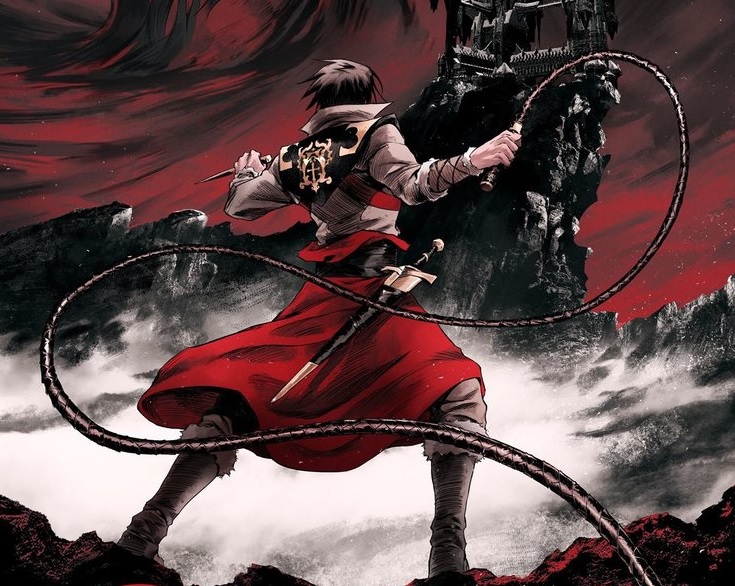 Shock news at full moon! Warren Ellis, the comics titan who scripted the acclaimed animated version of Castlevania, has never played a Castlevania game. But before you grab your stakes and pitchforks, here’s some more news: the adult cartoon’s producer and showrunner, Adi Shankar, is a massive fan of the games. Shankar was such a big fan, in fact, that he refused an offer to make a live-action version of Castlevania that would have been, shall we say, a loose adaptation. In other words, he turned down a heap of money rather than desecrate an icon of his childhood.
Shock news at full moon! Warren Ellis, the comics titan who scripted the acclaimed animated version of Castlevania, has never played a Castlevania game. But before you grab your stakes and pitchforks, here’s some more news: the adult cartoon’s producer and showrunner, Adi Shankar, is a massive fan of the games. Shankar was such a big fan, in fact, that he refused an offer to make a live-action version of Castlevania that would have been, shall we say, a loose adaptation. In other words, he turned down a heap of money rather than desecrate an icon of his childhood.
Like Ellis, you don’t need to be a Castlevania fan, or a gamer at all, to get into the new animated series. It’s what Ellis described as a “medieval horror” yarn in which vampires are crusading against humans, and a trio of heroes – not all of them human – rise up against them. We’ll look at Castlevania’s horror dimension below. But the history of the source games is fascinating whether you’re a gamer or not. Castlevania is a Japanese institution, inspired by Western legends, that’s now been turned into an animated series aimed at Westerners, but with heavy debts to anime – and as we’ll see, producer Shankar is as much an anime geek as a Castlevania one.
Castlevania is a long series. The first game debuted back in 1986, a year after the side-scrolling platform format was transformed by Super Mario Bros. The first Castlevania was made by the Konami company, and it appeared as a floppy disc on Nintendo’s Family Computer Disc System. It was ported the next year as a cartridge on Nintendo’s main machine of the day, the 8-bit Famicom (exported to Britain and America as the Nintendo Entertainment System.)
The first game involves the hero, Simon Belmont, prowling the vampire Dracula’s capacious castle and killing umpteen monsters with one of the franchise’s future icons, a magic whip. Although the game was a side-scroller, it added interest to the gameplay by scrolling both left and right in a single level as Simon navigates higgledy-piggledy stairways between platforms. The mix of jumping, climbing and ghoul-killing wasn’t so far from another near-contemporary, Namco’s Ghosts’n Goblins, while the use of “long” weapons may remind grey gamers of Taito’s Rastan Saga, a riff on Conan the Barbarian.
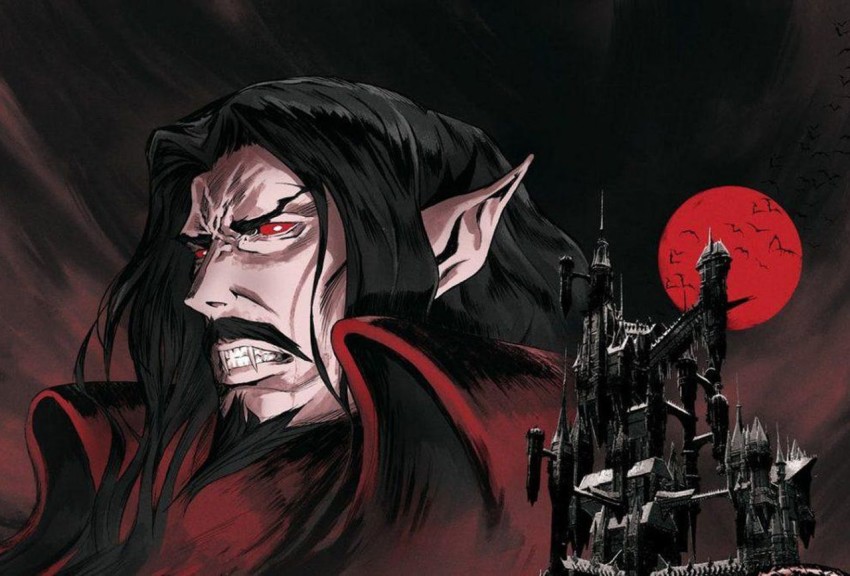 But much of the fascination of the Castlevania series through the next decades, with about thirty games in as many years, is how closely they reflect trends, styles and technical advances in the evolving games industry. The steady advances in sound and graphics were punctuated by anime-style cutscenes (as in 1993’s Castlevania game Rondo of Blood) and moves into 3D (as in the 1999 Castlevania for the Nintendo 64). By 2010’s Lords of Shadow, released for the XBox and Playstation 3, there were cinematic mo-capped animation scenes, voiced by actors like Patrick Stewart and Robert Carlyle. Carlyle voices that game’s protagonist, Gabriel Belmont.
But much of the fascination of the Castlevania series through the next decades, with about thirty games in as many years, is how closely they reflect trends, styles and technical advances in the evolving games industry. The steady advances in sound and graphics were punctuated by anime-style cutscenes (as in 1993’s Castlevania game Rondo of Blood) and moves into 3D (as in the 1999 Castlevania for the Nintendo 64). By 2010’s Lords of Shadow, released for the XBox and Playstation 3, there were cinematic mo-capped animation scenes, voiced by actors like Patrick Stewart and Robert Carlyle. Carlyle voices that game’s protagonist, Gabriel Belmont.
By the time Lords of Shadow came along, gamers had seen a good many Belmonts. As the franchise grew, it was revealed that the first game’s Simon was part of a long hero dynasty, stretching before and after him, all sworn to fight the resurrection-prone Dracula. As a device, it’s very similar to the manga saga Jojo’s Bizarre Adventure, which began just after the first Castlevania in 1987, and had many vampiric villains for the Jojos to defeat.
One of the first Belmonts we met in the games was Trevor Belmont, who debuted as the hero in 1989’s Famicom game Castlevania III: Dracula’s Curse. (The game’s a prequel, with Trevor an ancestor of Simon.) Castlevania III is another 8-bit side-scroller, but with more nifty tweaks – there are diverging pathways and allies for Trevor to find, who can themselves be controlled by the player on later levels.
One of these playable allies is a woman, Sypha, who Trevor initially saves from a monster – ammo for the “videogames are sexist” party – but who turns out to be a potent magic-using monster-fighter. Another of the allies is Alucard, the rebellious half-vampire son of Dracula himself. (Anyone who remembers how Trevor met him in the game will be pleased to see how the animation recreates the event.) Along with Trevor, Alucard and Sypha are the leads of the new Castlevania animated series. At least they’re the leads in the second season; Alucard has just a few scenes in the first, which foregrounds Trevor and Sypha.
The first Castlevania series, however, doesn’t start with them. Rather, it opts to begin with the backstory of the dreaded Dracula, or Vlad Dracula Tepes as he’s called here. This backstory is taken from yet another Castlevania game, 1997’s Symphony of the Night. The series starts with a young woman approaching the vampire’s giant-scaled castle, in a landscape that looks like Mordor’s heart. A caption reads “Wallachia, 1455.”
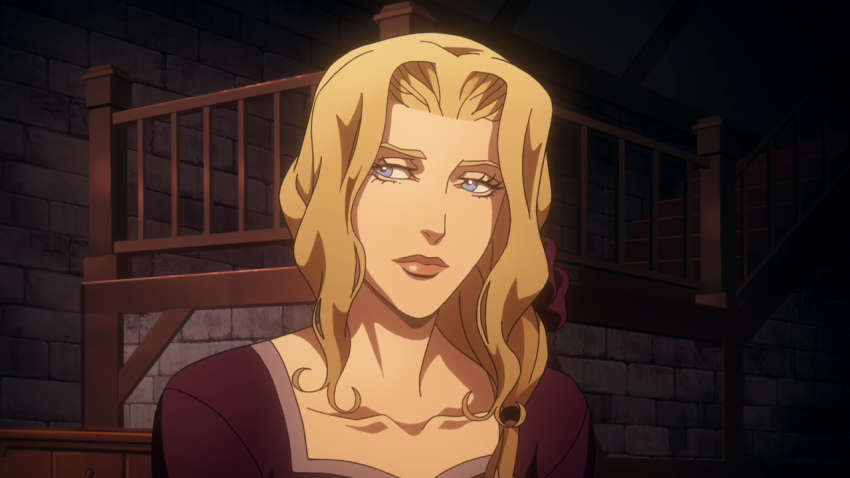 Upending expectations, the woman, called Lisa, hasn’t come to stake Dracula or to beg his mercy. Rather she wants to learn from him, not because she’s power-hungry, but from true altruism. Her people are suffering, and Lisa hopes Dracula’s knowledge may improve their lives. Unlike more trad vampires, this Dracula wields science, not dark magic. In his castle are halls of bubbling chemicals and gleaming instruments, delighting Lisa. Moreover, Dracula’s whole castle can move, materialising in new places like a giant TARDIS or the evil fortress in the retro-fantasy Krull.
Upending expectations, the woman, called Lisa, hasn’t come to stake Dracula or to beg his mercy. Rather she wants to learn from him, not because she’s power-hungry, but from true altruism. Her people are suffering, and Lisa hopes Dracula’s knowledge may improve their lives. Unlike more trad vampires, this Dracula wields science, not dark magic. In his castle are halls of bubbling chemicals and gleaming instruments, delighting Lisa. Moreover, Dracula’s whole castle can move, materialising in new places like a giant TARDIS or the evil fortress in the retro-fantasy Krull.
For his part, Dracula is in a mellow phase of his long life. When Lisa refers to his reputation for impaling people, he chuckles and says he gave that up long ago. Lisa’s fearlessness, her forthrightness, intrigues Dracula as no human has done before her. How their relationship develops is left for us to imagine – a vampiric version of Beauty and the Beast, perhaps. Enough to say that in a few years, Lisa becomes Dracula’s wife – without having to become a vampire – and the mother of his son, Alucard.
Then, as the first episode shows, things go terribly wrong. Dracula is elsewhere when Lisa is captured by the church – the medieval church, that is, with all the inquisitorial cruelties you can imagine. (The worst of the prelates is a Bishop, voiced by Matt Frewer, who once played the “virtual” megastar Max Headroom, a Western ancestor of Hatsune Miku.) Lisa’s fate is terrible; Dracula’s vengeance is worse. Maddened by what happened to the woman he loved, the vampire becomes, in effect, an Old Testament God, decreeing all humans should die for the crime. His monsters ravage the land, tearing people apart in a medieval apocalypse that’s likely to end humanity by 1500.
It’s only twenty minutes into the show that the hero Trevor is introduced. Interestingly, Warren Ellis’ script goes for a western equivalent to the wild tonal swings that are so common in anime. One minute we’re watching people getting dismembered and splattered. Then we’re in a bar overhearing a discussion about sex with goats that even Family Guy couldn’t get away with. Trevor’s drinking in the bar too; he’s a sour loner trying to hide his family name, as Belmont’s a dirty word in these parts. A bar brawl later, he’s driven to a nearby town under siege from Dracula’s monsters. He’s determined not to get involved; the series has other ideas.
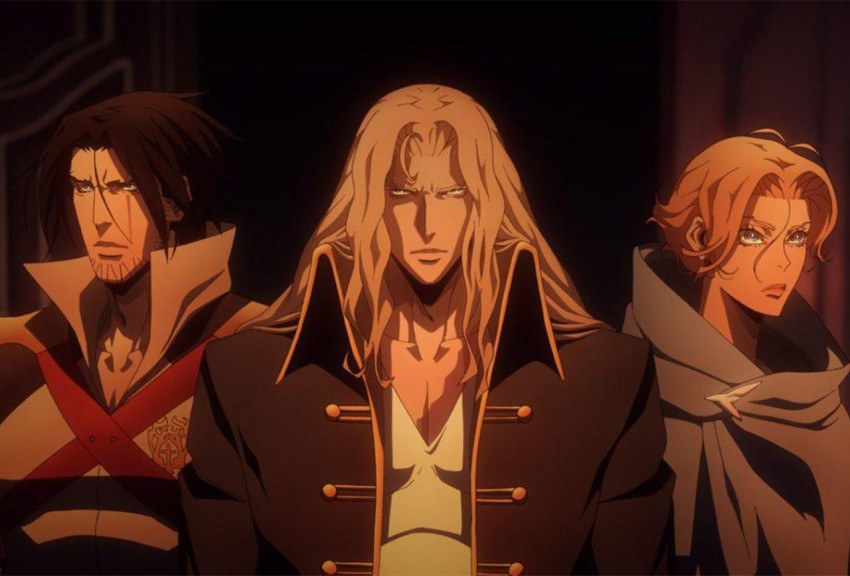 Adi Shankar, Castlevania’s producer, grew up moving between Hong Kong and other parts of Asia, seeing imports of Dragon Ball and Trigun and bloodier fare like the first TV Berserk, Vampire Hunter D and Ninja Scroll. As for Shankar’s broader geek credentials, he executive-produced the good film of Dredd, but more important, he also produced the fan films called the “Bootleg Universe,” offering new takes on Marvel’s The Punisher and James Bond. Shankar’s most celebrated “bootleg” was Power/Rangers, a glossy Watchmen take on the most preposterously kitsch Japanese import of all.
Adi Shankar, Castlevania’s producer, grew up moving between Hong Kong and other parts of Asia, seeing imports of Dragon Ball and Trigun and bloodier fare like the first TV Berserk, Vampire Hunter D and Ninja Scroll. As for Shankar’s broader geek credentials, he executive-produced the good film of Dredd, but more important, he also produced the fan films called the “Bootleg Universe,” offering new takes on Marvel’s The Punisher and James Bond. Shankar’s most celebrated “bootleg” was Power/Rangers, a glossy Watchmen take on the most preposterously kitsch Japanese import of all.
The Castlevania series isn’t anime, but it’s very anime-ish. Certainly it’s as gory – or gorier – than most anime horror shows. There’s a gross-out in part two, when Trevor’s whip catches someone’s face, which feels like the series saying “this is how far we can go,” like the earlier discussion about goats. You could reply that a big difference between Castlevania and real anime retro-horrors is that the latter treated women far less respectfully than Castlevania. Plenty of women get killed in Castlevania, of course, but they fare no worse than the men. Interestingly, a season two episode has Dracula sink his fangs deep into a man’s neck, an image that vampire films of past decades tended to avoid.
But then vampire anime are themselves cultural mishmashes – there were no vampire legends as part of Japan’s yokai traditions. It’s notable that the best vampire anime film, Vampire Hunter D: Bloodlust, was made very much for the world market, and recorded with the English voices first. For its part, Castlevania was animated by studios in different parts of the world, led by Powerhouse in Austin, Texas. An article on the Gizmodo website highlights how Powerhouse created much of the most important key animation, including set pieces like Trevor’s fight with a Cyclops to rescue Syphia.
But if you watch Castlevania’s end credits, you’ll see many South Korean names, because some of the animation was outsourced to a South Korean studio, MOI. Like many of the country’s animation studios, MOI has done contract work for anime productions, including Aldnoah.Zero, Harmony and the Berserk film trilogy. Beyond anime, MOI also contributed to another acclaimed anime-ish series, Avatar The Last Airbender. It wasn’t one of the main Avatar studios, but Castlevania’s combat scenes, fiery battles and primary palette are often reminiscent of Avatar, for all the extra splatter and swearing.
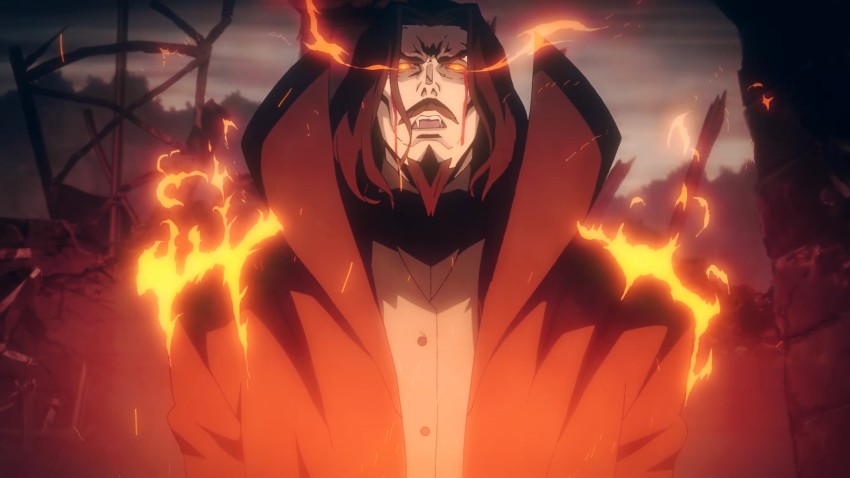 One point emphasised by the show’s creators is the “humanisation” of Dracula himself. Handsome and noble-looking despite the horrors he wreaks, given to brooding sadness in his vast castle, this Dracula has a clear model – Leiji Matsumoto’s space hero Captain Harlock, who was another anime character cited by Shankar in interviews. You may also be reminded of Captain Nemo in Secret of Blue Water, another Western character reimagined in the Harlock mould. Meanwhile, the whole “Lisa” backstory seems to come from one invented in Francis Ford Coppola’s Dracula film in 1992, which also involves a dead wife and a rift with a cruel church. (Coppola’s film also seems to have been a big influence on Vampire Hunter D: Bloodlust.)
One point emphasised by the show’s creators is the “humanisation” of Dracula himself. Handsome and noble-looking despite the horrors he wreaks, given to brooding sadness in his vast castle, this Dracula has a clear model – Leiji Matsumoto’s space hero Captain Harlock, who was another anime character cited by Shankar in interviews. You may also be reminded of Captain Nemo in Secret of Blue Water, another Western character reimagined in the Harlock mould. Meanwhile, the whole “Lisa” backstory seems to come from one invented in Francis Ford Coppola’s Dracula film in 1992, which also involves a dead wife and a rift with a cruel church. (Coppola’s film also seems to have been a big influence on Vampire Hunter D: Bloodlust.)
Like many Draculas, including Coppola’s, the Count of Castlevania is identified with the historic Vlad Dracula. He was the 15th-century Wallachian prince with a reputation for brutality, including the practice that inspired his nickname, “Vlad the Impaler.” Dracula’s original creator, the author Bram Stoker, was only peripherally inspired by Vlad Dracula. In Stoker’s 1897 Dracula novel, the vampire is much more of an infiltrator, leaving the mysterious East behind and insinuating himself into “modern” (that is, Victorian) British society. Interestingly, an anime that’s close in spirit to Stoker’s novel was officially based on a completely different book – Gankutsuou The Count of Monte Cristo, where another supernatural Count cuts a swathe through polite society.
The Castlevania animation has only a loose relationship to Stoker’s book – which is in contrast to its much closer relationship to anime, even though it’s not an anime. The point is articulated in the Gizmodo interview by two more creators of the show. One is Brad Graeber, who co-founded the Powerhouse studio. “(Anime) is tricky because people classify it by geography or style. That’s up to the person. But people need to get used to it. My generation was heavily influenced by Looney Tunes, the Disney films, that kind of thing. The talent that’s coming in now is influenced by anime.”
The other creator is Sam Deats, who was the character designer and the actual director of Castlevania. “I think any artist that’s been doing this for a while will tell you the same thing, that they are the sum of their influences. And if you’ve grown up being influenced by anime-style work, then that’s going to be the look and feel of the work that you’re doing.”
Andrew Osmond is the author of 100 Animated Feature Films. Castlevania, season one, is released in the UK by Anime Limited.
Leave a Reply